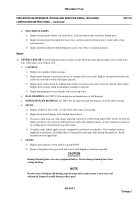TM-9-2350-277-34 - Page 124 of 871
TM 9-2350-277-34
PREVENTIVE MAINTENANCE CHECKS AND SERVICES (PMCS), INCLUDING
LUBRICATION INSTRUCTIONS — Continued
0014 00
CAUTION
Cleaning solvent causes leather, rubber, and synthetic materials to become brittle. Do not use
cleaning solvent to clean seals, cables, and flexible hoses.
a.
CLEAN EVERY PART.
Clean every part well after disassembly and before assembly or installation. Clean parts
such as housings, covers, and dipsticks before disassembly. Avoid getting dirt and foreign matter in a system.
Inspect and cap all air and fluid openings, lines, and hoses.
b.
HANDLE WITH CARE.
Use care when handling parts during cleaning and maintenance. Nicks, scratches, dents,
and burrs can prevent proper assembly or cause malfunctions after assembly. Keep hands free of grease. Grease
collects dirt. Cover or wrap parts to protect from dirt.
c.
AVOID ABRASIVES.
Except where specially called for in a task, don’t use abrasives, files, wire brushes, or sharp
tools. On some surfaces, finish is important to the operation of close fitting parts.
d.
REMOVAL AGENTS.
Remove gum or old grease deposits by soaking parts in cleaning compound. Scrub with a
brush. Use crocus cloth to remove minor surface defects.
e.
STEAM CLEANING.
If steam cleaning is used, dry parts at once with compressed air. Apply a thin film of
clean oil to surfaces that are not painted to prevent rusting. Never use lye of caustic mixtures that will corrode
or etch metal surfaces.
f.
LUBRICATION OF NEW BEARINGS.
See TM 9-214 for cleaning and lubrication procedures. Bearings that
have been in service should also be lubricated.
g.
CASTINGS.
1)
Clean inner and outer surfaces of casting with cleaning compound. Dry casting with compressed air.
2)
Remove sludge and gum deposits with a brush.
3)
Blow out all tapped holes and armor mounting inserts with compressed air.
h.
BALL BEARINGS.
Bearings require special cleaning techniques. See TM 9-214 for cleaning and maintenance
procedures for ball bearings.
i.
OIL PASSAGES.
1)
Make sure all oil passages are not clogged.
2)
Clean oil passages and break up any sludge or gum deposits.
3)
Flush oil passages with cleaning compound. Dry parts with compressed air.
j.
OIL SEALS, ELECTRICAL CABLES, AND FLEXIBLE HOSES.
Clean seals, cables, and flexible hoses
with detergent and water. Dry parts with wiping rag.
k.
INSERTS.
Blow out insert holes with compressed air.
l.
GASKETS.
If gasket is being removed, scrape old gasket material and sealant off mating surface. Clean mating
surface with cleaning compound
.Drywithwipingrag.
Inspection
9.
All parts must be inspected with care. Replace parts if damage or wear exceeds allowable limits.
a.
GENERAL
. Procedures for inspection will be the same for most parts. General inspection procedures are given in
the following steps. Special inspection procedures are covered in the task as needed.
b.
CASTINGS.
1)
Use magnetic particle inspection equipment to check ferrous castings for cracks. Use a magnifying glass and
strong light to check nonmetal castings for cracks. Check areas next to studs, threaded inserts, sharp corners,
and fillets.
001400-5
Change 5
Back to Top




















